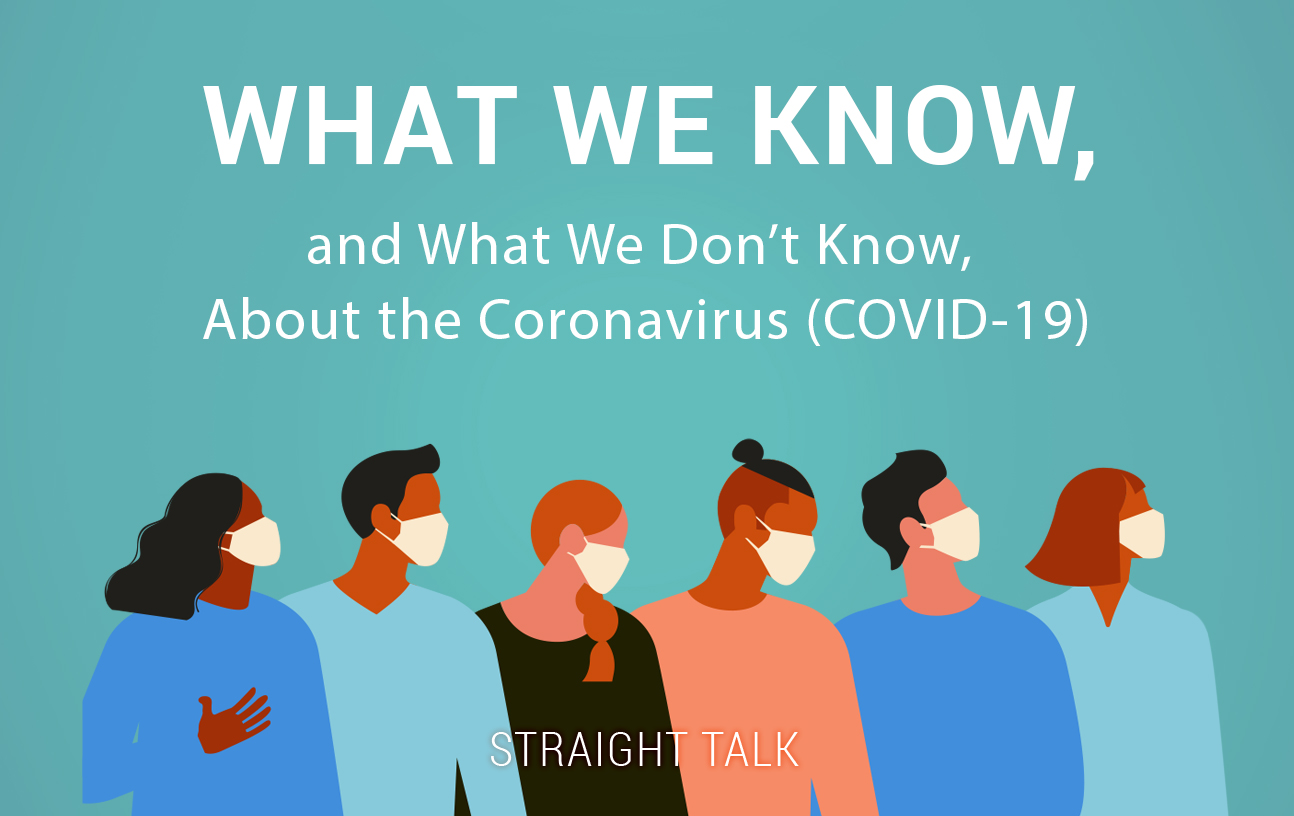In case you missed it, it’s cold and flu season. Hopefully, you are following the advice medical and public health professionals have been giving for years: Get your flu shot, wash your hands regularly, avoid huge crowds, try not to touch your face and, for God’s sake, keep your fingers out of your nose! (Quit denying it, I saw you!) Likewise, if you start to feel bad, running fever and the like, don’t go to work, school or public gatherings, and see a healthcare provider as soon as possible.
These habits will serve you well in the face of the latest viral threat, the new coronavirus, formally named COVID-19.
On Monday, Louisiana announced its first presumptive positive case of COVID-19. By Thursday at 9:30 a.m., the state of Louisiana had confirmed 14 presumptive positive cases in the state. The Louisiana Department of Health is updating case numbers online twice a day at LDH.Louisiana.gov/coronavirus.
When he announced the first case, Gov. John Bel Edwards stated that Louisiana has been preparing for this moment for many weeks. We here at Blue Cross are also making sure we are ready.
What is COVID-19?
We are still gathering data, but what is clear is that COVID-19 is a disease caused by a fast-spreading coronavirus that seems to have started in an area of mainland China with a population of more than 10 million people. Of course, in our modern age of air travel and crossing borders, many more cases of COVID-19 have popped up in many other countries since the beginning of this year.
Coronavirus is a respiratory illness that can spread person to person, like flu or the common cold. It appears to be more dangerous for people who are older, have lots of health conditions or have weakened immune systems. Other people who have gotten COVID-19 have had milder cases and recovered, though health officials are telling us that means total cases may be underreported.
It’s a bit early for any more precision than that, and international and local public health agencies are releasing updated information daily, so this is a very fluid situation.
This is a good time for me to apply a little Straight Talk to the nonsense and misinformation I’m seeing, reading and hearing in the media about this particular bug.
As Gov. Edwards said about coronavirus, “there is no need to panic,” and Louisianians should prepare for this virus much the same way they prepare to avoid any disease that spreads person to person, like the annual flu we deal with every year. In the U.S., the flu infects anywhere from 10 million to over 60 million people, causing an average of 50,000 Americans to lose their lives.
COVID-19 is NOT the Same as Spanish Influenza!
On multiple occasions, I’ve read articles where reporters or so-called healthcare “experts” claim that COVID-19 is just as deadly as the Spanish Influenza of 1917-1918. Their reasoning goes something like this: “Well, the mortality rate of the Spanish Flu was 2%, and that’s close to coronavirus (COVID-19)!”
For the record, the World Health Organization cautions that because this is such a fluid situation and cases are likely underreported, the mortality rate for coronavirus will take time to be fully understood. Current data indicate the crude mortality ratio (number of reported deaths divided by reported cases) is 3-4% for coronavirus.
But, any comparison to the Spanish Influenza is so wrong as to be almost criminal. Let’s look at the numbers:
In 1917-1918, a type of influenza that we now formally call H1N1 ravaged the planet. As many as 500 million people (out of the slightly fewer than two billion people on the whole planet at that time) are estimated to have caught the bug, and over 10% of them (more than 50 million people) died from it.
“So Mike, where are they getting the 2% Spanish Influenza mortality rate from?”
Simply put, H1N1 killed 2% of the entire planet in about two years. But that’s an apples to oranges comparison, so be careful — of the people who CAUGHT H1N1, more than 10% died from it. Pretty grim. What made H1N1 even worse was that it mostly was fatal to younger people, in their 20s and 30s, not the very old or very young who are more susceptible to typical seasonal flu.
The WHO’s current coronavirus mortality rate is looking at people who caught the virus and died from it, which at this time is much lower than that comparison for Spanish Influenza.
Another big difference is that in 1917-1918, no one had actually SEEN a virus in a lab or could confirm they existed. The roles of things like anti-virals and hydration, the right way to quarantine someone, or how to stop the spread of a virus, were all unknown at that time. It’s a much different world now, especially in a first-world healthcare setting like the United States. In fact, a variant of H1N1 known as the “swine flu” (because it was believed to have jumped from pigs to humans) emerged in 2009, with much less effect. Technology and understanding of where diseases come from and how they spread makes a difference.
So at this time, any comparison of COVID-19 to the Spanish Flu (H1N1) is irresponsible and misleading. But sadly, there is a lot of that going on right now.
“So, Mike, how worried should we be about COVID-19?”
Well, like any new virus, there are some things we don’t know yet. Testing kits for COVID-19 are becoming more widespread, so it’s likely that as public health officials start implementing them, you’ll be hearing reports of clusters of COVID-19 in different cities around the U.S. “popping up.”
Health officials have cautioned that because the number of cases has likely been underreported, the odds are that many cases “popping up” were in the population already. The majority of people who test positive for COVID-19 are reporting mild symptoms, similar to a cold. In those circumstances, people might not jump straight to “I have COVID-19” when considering if they need medical attention and what kind.
For a while, I expect news reports on every case that is confirmed. Clusters of cases will continue to be reported as they are confirmed through testing. Since this bug spreads person-to-person, you may see reports of large, public gatherings being canceled. That’s to be expected, to help stop COVID-19 from spreading.
Since this bug is especially hard on those who have compromised immune systems and the elderly, and can be dangerous in those populations, we all need to take it seriously. Especially if you care for someone who is elderly or immune-system compromised, you should be extra careful when in contact with them, and wash your hands often.
It’s critical that you get your information on coronavirus from reliable sources. Here are the best ones:
- U.S. Centers for Disease Control and Prevention (CDC) Coronavirus Disease page
- Louisiana Department of Health Coronavirus (COVID-19) page
- The Coronavirus General Information Line, 1-855-523-2652 (available 8 a.m. – 4:30 p.m. Monday through Friday)
It’s important to note that corona-family viruses have been around for years, and, in addition to humans, they can appear in dogs, cats, camels, bats and cattle. As far as the origin of COVID-19, I don’t think anyone knows for sure at this point.
What is Blue Cross doing about coronavirus (COVID-19)?
Here at Blue Cross, we’re closely monitoring the spread of the coronavirus and how it could affect our members, employees and the communities that we serve. Just like we prepare for weather situations such as hurricanes and floods, we have contingency plans in place to make sure you have access to the care and medications you need.
Our leadership and clinical officials are following federal and state recommendations regarding the coronavirus. During this situation, we will:
- Waive prior authorizations for tests and covered services that are medically necessary and consistent with CDC guidance.
- Cover the full cost of medically necessary diagnostic tests that are consistent with CDC guidance related to COVID-19 –with no cost share to our members.
- Increase access to prescription medications by waiving early medication refill limits on 30-day prescription maintenance medications (consistent with your plan and coverage) and/or encouraging the 90-day mail order benefit.
Don’t forget that Blue Cross customers and dependents covered on their plans can use BlueCare, our service for 24/7 online doctor visits. I’ve had good experiences using BlueCare, which works on any device that has internet and a camera. This could be a good option if you feel too ill to leave the house or you want to consult with a healthcare provider before you go somewhere for treatment. It’s easy to use on any tablet, smart-phone, or computer.
Check out the Blue Cross COVID-19 webpage for ongoing updates.
Straight Talk is, follow all the same procedures you would to avoid getting any disease that can spread person to person (flu, colds, stomach viruses, coronavirus, etc.): Wash your hands for an extended period of time as often as you can (at least 20 seconds), using soap. A very common transmission method of COVID-19 is believed to be through your ocular mucosa, which is a fancy way of saying don’t touch your eyes or face if you can help it.
At this point, coronavirus bears watching, and we certainly will keep doing that.





A ton of other providers and companies are helping the American people in so many ways by taking caps off especially considering mother’s like myself have children we are teaching at home. What is straight talk doing for their customers and American people? You guys already changed the plans without our knowledge months ago and it was no longer technically “unlimited” hotspot or anything..you seem to have a way of progressing towards other subjects but not what STRAIGHT TALK IS doing for their customers and the people?? I’ll also post this on Facebook so others can interact with this conversation. Thank you
I’m not 100% sure but I think you may have Blue Cross and Blue Shield of Louisiana’s Straight Talk blog on healthcare and health insurance mixed up with the Straight Talk wireless service. If not, please reach back out to me, but we are a healthcare blog, not a wireless carrier.
Sorry for the confusion!…..mrb
Straighttalk should give their customers a break on hot spot gigs